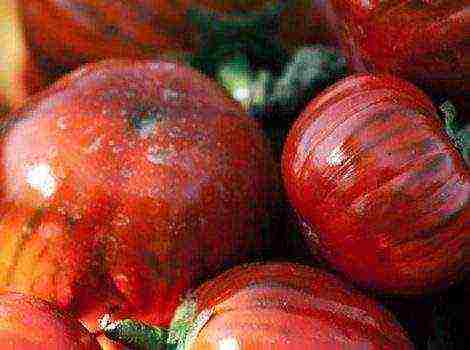Content
- 1 Early maturing layers Loman Brown
- 2 Leghorn: Egg Breed Champion
- 3 Rhode Island: American Giant Layers
- 4 Graceful Minorks
- 5 Noble handsome Sussex
- 6 New Hampshire: "cousin" of the Rhode Island breed
- 7 Russian White: the pride of the Russian poultry industry
- 8 Early maturing layers Belarus 9-U
- 9 Tetra: universal cross
- 10 Egg chickens: what are they?
- 11 Rating of the best breeds
- 12 Conclusion
- 13 Photo gallery
- 14 Video "White Leghorn on the Walk"
- 15 First place of the leader
- 16 Second place - Hisex Brown
- 17 Third place - Tetra chickens
- 18 Fourth place - Leghorn
- 19 Video "Features of keeping thoroughbred layers"
All chicken breeds are divided into three performance categories:
- egg;
- meat;
- mixed.
When breeding egg breeds, the main emphasis is on such characteristics as egg production (the number of eggs produced by one individual during the year). The weight of chicken egg breeds, as a rule, is small, they are not suitable for breeding "for meat".
Laying hens of different breeds on the perch
All chickens of egg breeds are characterized by early maturity (which "starts" the egg-laying process). On average, egg-laying breeds begin to lay at the age of 4-5 months, while in meat breeds, egg-laying begins 2-3 months later. Other distinctive characteristics of egg breeds are:
- low weight (up to 2.2 kg in females and up to 3 kg in males);
- activity and mobility due to rapid metabolism;
- good appetite (on average, a chicken lays an egg once every 25 hours, so it needs constant nutrition for the body).
Egg breeds of chickens
The egg production of a particular individual is determined by the number of eggs in its body. This amount is laid down already at the birth of the chicken and does not change throughout life. The average number of eggs in the body of a female of egg breeds is about 4 thousand, but this does not mean that a hen will produce exactly that number of eggs during her life. It will take a laying hen 15 years to realize the set amount of eggs. Chickens raised in private households and poultry farms never survive to this age. The peak of egg production in layers occurs at 3-4 years of age. As a rule, after a decrease in productivity, individuals are culled.
Performance table of chickens of some breeds
The record holder for the number of eggs laid is a representative of the Leghorn breed named Princess. In 1930, she produced 361 eggs, that is, it was laid almost daily. This is an impressive figure, considering that the egg production of industrial laying hens is 200-220 pieces.
Egg production records
The most productive of the egg-bearing breeds are currently considered:
- Loman Brown;
- Leghorn;
- Rhode Island;
- Minorca;
- Sussex;
- New Hampshire.
Early maturing layers Loman Brown
Loman Brown chickens are capable of producing about 280-300 eggs per year, while the eggs themselves are large (over 60 g). It is also one of the fastest maturing egg breeds: females begin to lay as early as 136 days old. The maximum egg production starts from the age of 170-180 days.
Young chickens Loman Brown
Show on page Open in full size
Of the disadvantages of the breed, the short duration of the peak of laying can be canceled. It is a maximum of 80 weeks (in other breeds - from 100 weeks). Then the egg production of individuals drops rapidly. Their maintenance becomes unprofitable and the livestock is renewed.
Chickens Lohman Brown
Layers of the Lohman Brown breed are completely non-capricious in breeding: they calmly react to fluctuations in temperature regimes and adapt to almost any feed. The form of keeping (cage or walking) does not particularly affect egg production, which is another advantage of the breed.
Lohman Brown - breed of chickens
Leghorn: Egg Breed Champion
The highest productivity is demonstrated by Leghorn chickens. She went through many stages of selection before she was able to derive the current egg production rates. Currently, Leghorn is considered the most demanded breed of chickens for industrial breeding in the world.
Leghorn
There are several varieties of the breed, the most common being the White Leghorn. One layer is capable of producing 300 eggs per year with an average weight of 56-58 g.
Adults are small in size: females up to 1.6 kg, males up to 2.6. Oviposition occurs at 22-24 weeks of age. Laying hens reach the peak of egg production in the first year of life, then productivity begins to gradually decline. In large farms, chickens are kept for up to a year, then they are slaughtered, because their content becomes unprofitable.
Leghorn chickens
The optimal form of breeding is considered to be cellular: layers feel great in a closed space. The main condition for maintaining productivity is to ensure sufficient lighting in the premises.
Another advantage of the breed is its low feed consumption. Leghorns eat little and never overeat due to their metabolic characteristics. But at the same time, if the balance of proteins and minerals in feed mixtures is disturbed, as well as if they are given insufficiently clean and fresh water, the hens can significantly lose in productivity.
Leghorn chickens - productivity
Rhode Island: American Giant Layers
Among the egg types of chickens, representatives of the Rhode Island breed are considered giants, they are successfully raised both for eggs and for meat. The average weight of cockerels ranges from 3.1 to 3.8 kg, individuals over 4 kg are often found. Females weigh an average of 2.5-2.9 kg. The largest mass is reached by individuals in the diet of which green food predominates.
Rhode Island chickens
Other characteristics of the breed:
- Egg production - up to 170 eggs per year;
- Egg mass - 58-63 g;
- Onset of laying - 210 days;
- The hatchability is up to 75%.
Like the Loman Brown breed, Rhode Islands are characterized by unpretentious maintenance. They feel comfortable even in primitive poultry houses, without separate nests. The breed is resistant to low temperatures, with sufficient light and balanced nutrition, egg production is maintained even in severe frosts. Rhode Island chickens are highly immune to most diseases that affect chicks from other egg breeds.
The only drawback of Rhode Island is the poorly developed hen instinct in chickens.
Graceful Minorks
There are three lines of the breed: black Spanish Minor cats, whose gene pool is now almost exhausted, white-silver British and dwarf. The last line is experimental, the maximum mass of dwarf minoros does not exceed 1 kg.
Rooster and Minorca chickens
For commercial breeding, the British breed standard is currently used. Females of the British Minorca weigh an average of 2.3-2.5 kg, males - from 3.2 to 4. Along with the Rhode Island breed, the Minorcs are equally well suited for both egg and meat breeding.
Minorca chickens on the run
Minoroc eggs are distinguished by the largest weight - up to 80 g. True, only laying hens in the second year of life are capable of producing eggs of such a mass. Youngsters, just entering the age of laying, produce eggs up to 60 g in weight. The egg production of young animals is higher than that of second years and is up to 170 pcs. per year, while individuals in the second year of life are able to carry a maximum of 140.
A feature of the Minorca chickens is the close dependence of productivity on the purity of the breed.Therefore, individuals with signs of deviation are discarded even before the onset of puberty.
Egg breed of Minorca chickens
Show on page Open in full size
Minor cats (both young and adult chickens) are very sensitive to changes in temperature and humidity. To maintain productivity, it is important to keep the livestock in dry and well-insulated poultry houses.
Keeping chickens in a winter poultry house
Noble handsome Sussex
Individuals of this breed are distinguished by their elegant appearance. Chickens with a characteristic pattern on the neck and tail attract attention with their gracefulness. There are many color options for individuals: Colombian, fawn, white, lavender, porcelain, brown, etc.
Light Colombian Sussex
The most popular in Europe and Russia is Colombian. Representatives of this species are white in color with a dark "necklace" around the neck. The ends of the flight and tail feathers are also painted black.
Sussexes in the poultry house - photo
The main characteristics of the breed are as follows:
- weight - 2.4-2.7 kg (females), 3-4 kg (males);
- egg weight - 56-58 g;
- beginning of oviposition - 5th month of life;
- productivity - 170-190 pcs.
The Sussex breed is very early maturing: with proper care, young animals gain slaughter weight at 100-120 days of life. The egg production of the breed depends on the season: in winter, productivity drops significantly, therefore, in large farms, chickens are often slaughtered with the onset of cold weather.
Sussex chickens
New Hampshire: "cousin" of the Rhode Island breed
These layers were bred by American breeders based on the Rhode Island breed. New Hampshire chickens weigh slightly less than their counterparts, but are also less voracious. The weight of the female is from 2.1 to 2.9 kg, of the male - up to 3.75 kg.
New Hampshire
The eggs of New Hampshire hens have a pleasant yellow-brown color, weight 1 pc. - up to 60 g. The maximum egg production is observed in the first year of life of individuals (up to 200 pieces), in the second - up to 160, in the third - up to 140. It is unprofitable to keep individuals older than three years.
Chickens of the New Hampshire breed
Adult chickens and cockerels are distinguished by a calm character, they can coexist without problems with representatives of other breeds. New Hampshire can withstand temperature extremes and the vagaries of the weather. To maintain productivity, laying hens require a variety of food; on some compound feeds, New Hampshire quickly "blown away". In their diet, greens, grated root vegetables, eggshells must be present.
Chickens of New Hampshire are unpretentious in food and in conditions of detention, today they are often used in industrial poultry farming and household plots.
Russian White: the pride of the Russian poultry industry
To breed this breed, Soviet breeders used white leghorn roosters with females of local species. The breed standard is pure white plumage of individuals with a bright red crest and "earrings". The live weight of females is from 1.6 to 1.8 kg, of males - 2-2.5 kg.
Chickens breed Russian White
Russian White belongs to small-egg breeds (egg weight does not exceed 56 g), but it demonstrates good productivity (200-230 pcs per year). The record for the egg production of individual individuals is 300 eggs per year. The eggs produced are white and have thin shells.
Young russian white chicks
For best performance, hens should spend most of their daylight hours on the pasture. When kept in closed pens, it is important to maintain a comfortable microclimate for birds: Russian whites do not tolerate humid air, so the humidity level should not rise above 70%. The temperature in the pen should not be allowed to fall below -2 ° C: the birds will immediately freeze the ridges, which will significantly affect egg production.
Young chickens and rooster breed Russian White
Early maturing layers Belarus 9-U
A cross of egg chickens, adapted for growing in the climatic conditions of the middle zone. The breed is early maturing (the first eggs of a hen are laid on the 135th day of life), while keeping such birds is very profitable. An adult individual consumes no more than 115 g of compound feed per day.
Cross "Belarus 9-U"
The average weight of females is up to 2 kg, males are not much larger - up to 2.5 kg. Egg production of the breed - 250-260 pcs. Small eggs - 59-60 g.
Tetra: universal cross
A hybrid breed of laying hens, suitable for growing for slaughter. In connection with the meat and egg orientation, poultry breeds need a verified diet. It is imperative that the daily intake of calcium and proteins be observed by individuals, which is necessary for the regular formation of eggs. If the diet of layers is insufficient or unbalanced, this will quickly affect the health of the birds.
Chickens Tetra for a walk
Show on page Open in full size
The egg production of the breed is high - the female is able to lay 230-250 eggs during the year. The Tetra hybrid is relatively early maturing, egg-laying begins as early as the 21st week of life.
Chickens of the Tetra breed
An adult female weighs 2 - 2.5 kg, a male - 2.8-3.5. Since the Tetra breed belongs to cross (hybrid), the size of individuals is slightly larger than that of classic egg breeds.
Video - Laying hens Loman Brown and Hisex
Video - Keeping laying hens
Choosing egg-laying chickens for home breeding is not an easy task. However, having some knowledge in this direction, it is quite possible to cope with it. That is why we bring to your attention the best breeds of laying hens. Their description and characteristics will help you choose worthy candidates for keeping at home.
Egg chickens: what are they?
There are different breeds of chickens of the egg direction, which differ in their ability to lay high-quality and large eggs. But they all share a number of common characteristics. First of all, it is worth noting their low body weight. Their weight very rarely exceeds 2.5 kg. In this regard, their backbone is also quite light.
It is worth noting that the egg breeds of chickens were bred specifically in order to obtain quality eggs. Therefore, breeders paid special attention to this very moment, while the meat qualities of birds are ignored.
Special attention should be paid to the fact that egg-laying chickens develop very quickly. By the 140th day after birth, they are fully physically developed. At the same time, the ability to lay eggs is noted in them after 125 days.
In addition, egg breeds of chickens have external similarities. They have a well-developed plumage. The tail and wings are impressive in size. On the head there is a persistent straight ridge with seven teeth. What are the most egg-laying breeds, we invite you to find out right now.
Distinctive features of layers
If the plans include breeding birds, you need to figure out which laying hens are suitable for this. The best option is considered to be a chicken of the egg direction, purchased in the area where breeding will take place. Of course, this plays an important role only if there is no desire to breed thoroughbred animals.
External parameters
All layers will differ from each other only in weight. Compared with meat-based birds, they are light and mobile. They have dense plumage and well-developed earrings. The ridge is leaf-shaped. It is worth paying special attention to him, since he is able to tell a lot about the bird.
If three-month-old layers have a developed comb of bright color, then the egg-laying will be active. When the comb takes on a pinkish tint, you can think about the presence of diseases or about poor maintenance at home. For this reason, if chicken is needed, look for scallops.
Egg description and body weight
Laying hens often lay eggs of large sizes. At the same time, their shell is distinguished by a white color. Due to the decrease in the weight of the bird, the cost of the eggs that it produces decreases. The standard weight should not exceed 1.9 kg. If a mini chicken was purchased, the weight level is reduced to 1.4 kg.
It is required to highlight that the low weight possessed by layers is not able to affect productivity. For this reason, the benefit can be obtained if you purchase an individual with a small weight index. Such a chicken will require less feed, which will lead to savings in its maintenance at home.
Egg breeds are usually called early maturing. This is due to the fact that the egg-laying period begins at the age of four months. Weight indicators at such moments are equal to only 75% of the average weight of an adult bird. It is also necessary to understand that the representatives of the breed rarely hatch eggs. If you plan to breed birds at home, you will need to purchase an incubator.
Rating of the best breeds
In order to choose a worthy option for chickens, you should pay attention not only to the external features of the bird, but also to the egg production indicators. If, of course, this is the goal pursued. One of the most popular breeds can be safely called Leghorn. It contains all the best qualities possessed by the world-famous breeds of laying hens.
Another variety that requires special attention is Isa Brown. Chickens bred by French breeders do not produce white, but brown eggs. Moreover, their number per year is within 320 pieces.
The following types of chickens can compete with the listed breeds:
- Russian white;
- Lohman-Brown;
- Highsek;
- High Line;
- Kuchinskaya Jubilee.
Loading …
Lohman-Brown
These chickens have excellent egg-laying characteristics. Their eggs have a dense shell, they are large enough and are brown in color. The active lay period can last 80 weeks. Each year, one laying hen is capable of producing about 320 eggs.
Russian white
The name of these chickens already determines the description of these birds. The feathers of the representatives of this genus are white, the body of the chickens is covered with yellow down after birth. The head is medium in size, the beak is yellow. Like all layers, the body is long and wide. The wings are dense and well developed. Russian white was bred taking into account severe cold weather and is resistant to some diseases.
The breed is characterized by increased egg production. In the first year, the hen is capable of laying about 200 eggs. The weight of one unit of the product is within 55 grams. Egg shell color is white.
Hisex
If you still have not decided which breed to choose, then you should give preference to the representatives of this species. Their egg production is about 300 eggs per year. In order to get about 10 pieces, you need 1.20 kg of feed. At the same time, the mass of one egg reaches 60 grams. In addition to the fact that the Haysek laying hens are famous for their decent productivity, they are resistant to various infectious, fungal and helminthic diseases. Moreover, they do not need to create special conditions of detention.
The breed was bred in 1970. It happened on the territory of Holland. Given the selection parameters, Hysek is considered a Leghorn hybrid. Breeders managed to create several varieties of the breed - Highsex White and Highsex Brown. The former are light in color, the latter are brown. Higher productivity is characteristic of Browns.
Highsek White
Hysek breed hybrid white is small in size and light bones. They resemble Leghorn in appearance. A peculiarity of birds should be considered a gorgeous crest, which, due to its size, is not able to stand in an upright position, hanging to one side.
The plumage should be attributed to the characteristic features. It is silky and quite pleasant to the touch. Regardless of the active lifestyle, chickens have a balanced temperament.
Highsek White have the following main characteristics:
- egg production per year can be about 280 eggs, 65 grams each;
- hatchability of juveniles reaches 95%;
- eggs are white;
- home-bred birds are resistant to infectious diseases;
- the weight of the female does not usually exceed 1.8 kg;
- the incubation instinct is extremely poorly developed;
- have a calm character.
A chicken of this breed needs good maintenance. Mineral dressing should be added to the diet. Any violation of the content norm will negatively affect productivity. Especially if you do not follow the recommendations for feeding.
Hisex Brown
Breeding work began in 1968. Two years later, the birds were sold all over the world. At the present stage, there is no other breed among domestic birds that would have such a high productivity. For 80 weeks of life at home, a chicken is capable of laying about 363 eggs.
In order for 10 eggs to be obtained, the bird needs to be given only 1.28 kilograms of feed. Eggs weigh up to 70 grams. The average weight of the bird itself reaches one and a half kilograms.
High Line
Laying hens of the Hy-Line breed have a calm temperament. At the same time, they perfectly adapt to any conditions of detention. It should be noted that their productivity does not depend on the conditions where they live. The eggs of these chickens are impressive in size and have a strong shell. By reaching 80 weeks of age, a hen can produce about 350 eggs per year.
Kuchinskaya Jubilee
Besides the fact that this breed is egg-producing, it is also an excellent source of meat. Chickens are 2-3 kg. Their meat has excellent taste and even surpasses broiler meat in the amount of protein. Layers begin to perform their functions when they reach 6 months of age. They are capable of producing 220 eggs per year. The weight of one unit of the product is 60 g.
Isa Brown
We present to your attention the description of Isa Brown chickens. These chickens are well acclimatized and are able to adapt to various conditions of detention. This species was bred by French breeders.
For a year, Isa Brown chickens are capable of laying up to 320 eggs. Their shell is colored brown. On average, an egg weighs 63 grams. Chickens begin to rush 135 days after birth. In cage conditions, birds need 110-114 grams per day. compound feed.
Leghorn
Leghorns are small but highly productive birds. If you look at these layers more closely, you can see how beautifully built they are and what ideal shape they have. Their head is slightly shifted to the stern, the chest is protruding. When they move, these white chickens look very impressive.
The description of representatives of the genus Leghorn is as follows: their head is medium in size, the crest is leaf-shaped, the earlobes are usually white, the body is light, the chest is wide, the legs are of medium length. The weight of the females varies within 1-2 kg, for the males - 2-2.6 kg. As for the ability to lay eggs, they can produce about 300 eggs per year. Leghorns acclimatize without problems. In addition, they are quite hardy and early maturing.
Already at the age of five months, Leghorn begins to lay his first eggs. In the first year of life, they have the highest productivity. Leghorn eggs are large enough, have a high fertility.
If you want to pick a really decent breed of chickens, then these birds are definitely worth considering.
Tetra
If we talk about a general description of the birds of this breed, then they differ in average size. They have a leaf-like comb, a strong beak, a small tail, short white or light yellow legs. In the first year, the hen can lay about 250 eggs. Such indicators of egg production are very much appreciated by farmers. Special attention should be paid to the fact that representatives of the Tetra genus begin to give eggs already at the 21st week of their life.
Minorca
The name of this bird comes from the place where this breed was obtained. It was bred by Spanish breeders on the island of Minorca.A little later, she fell into the hands of the British, where there was an improvement in her qualities. Intensive egg-laying in Minorca chickens begins at the age of 5 months. In the first year, they are capable of laying over 160 eggs. They are white and weigh about 55 grams.
Rhode Island
The Rhode Island breed has a number of features that make it possible not to confuse them with other chicken breeds. The birds have a medium-sized head with a pinkish straight crest, a very well-developed body, and a wide chest. Since these are layers, their backs are both long and wide. Paws are yellow.
Also one of the main distinguishing features of Rhode Islands is their color. At the base of the feather they are usually red in color, in the middle part they are brown-red, and at the end they are already dark in color. By the way, if the nib is dark, then this is purebred Rhode Island.
This breed is also a carrier of the gene for goldenness, which allows farmers, when breeding poultry, to determine the sex of chicks and make selection already at one day of age. In chickens, there is a spot on the back of the head, along which selection is made. This breed is not called egg for nothing.
In the first year of life, they produce about 200 eggs. They are brown in color, and weigh an average of 58 g. In addition to high egg production, this breed is distinguished by the instinct of incubating eggs.
New Hampshire
New Hampshire was bred from the Rhode Island breed. The main difference is the color of chickens and their physiological characteristics. The main task of breeding this breed was to increase the volume of egg production, as well as the level of hatching of offspring. And the breeders succeeded. The chicken begins to lay from the age of three months, the eggs weigh about 65 g on average, and the eggs themselves are brownish.
In addition to high egg production, chickens are resistant to climatic changes. Also, their fertility is about 80%. This is a very good indicator. Keeping this breed will not be difficult, because the chickens are very calm, and they can be housed in cages. They are quite large. Females reach an average of 3 kg, and males 4 kg.
Conclusion
To choose a suitable breed of chickens, you should first study the description of the specimens that you liked. At the same time, conclusions regarding a suitable option can be drawn based on the photographs presented in our material. More detailed characteristics of each breed can be found on our website.
Photo gallery
Video "White Leghorn on the Walk"
We invite you to watch a video showing white Leghorn chickens. They walk, nibble the grass and simply amaze with their snow-white color.
The best breeds of laying hens are not always easy to choose. Each species has its own egg production, features of care, maintenance and feeding. The article will discuss the best breeds of laying hens, their personal characteristics and shortcomings.
What are the features of egg chickens? 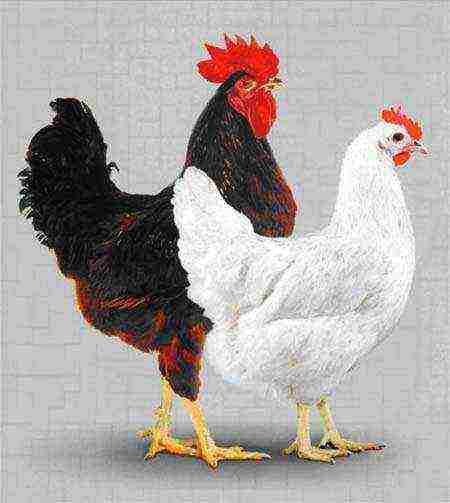 Leghorn breed
Leghorn breed
The best breeds of laying hens have only one main function for which they were bred - large, high-quality eggs. Most of the egg-laying hens, which are laid frequently, have similar characteristics.
- Body weight rarely reaches 2.5 kg. In content, they are quite beneficial, as they eat very little.
- Rapid development is good news for breeders. By the age of 140, the young are fully developed. And young females can lay eggs even earlier, already from 125-137 days.
- Outwardly, chickens and roosters of different breeds are quite similar. They have a well-developed plumage, a large tail and wings, the size of the comb may differ, but in chickens it is almost always worth it.
- Most chickens in this direction have completely lost their maternal instinct. They do not incubate eggs and do not look after the young. Therefore, for breeding, it is better to start an incubator in advance and special cages where the chickens will be kept until they get stronger.
Read how to increase the egg production of chickens at home - here!
Description of the best breeds of layers 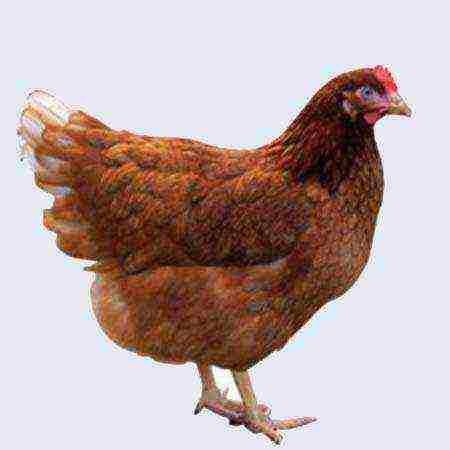 Breed Lohman Brown
Breed Lohman Brown
- Leghorn - the most common egg-laying species.They weigh very little - 1-2 kg of chickens and 2-2.6 kg - roosters. The hen produces about 300 eggs per year. They easily adapt to different climates, are hardy, early ripening. One of the features of the breed is that Leghorn chickens never overeat, but their feed must be nutritious, otherwise the quality of the eggs will be greatly affected. The record for the number of eggs laid in a year was registered for a hen named Princess, of this breed. She laid 361 eggs in 1930. That is, it rushed almost every day!
- Isa Brown - French breed, which easily survives in any climate, it is also not particularly important to the conditions of detention. They rush from 135 days old. For a year, you can get 320 eggs weighing 63 g each from one chicken. The shell is brown in color.
- Lohman Brown They lay eggs of brown color with a dense shell. For a year, the Loman Brown hen gives up to 320 eggs weighing 60 g. The reproductive age begins early, already on the 136th day of life.
- Russian white also belongs to the best breeds of laying hens. Lays white eggs, each weighing 55 g. Already in the first year of life, it produces 200 eggs.
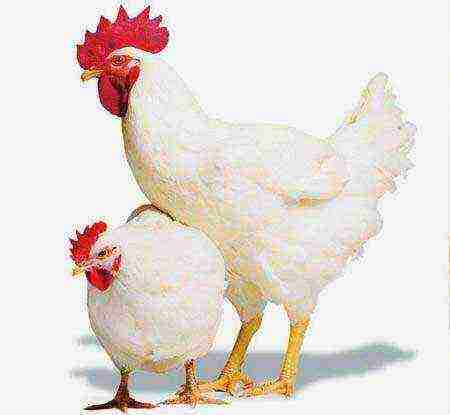 Breed Russian white
Breed Russian white - Hisex are distinguished by excellent health. They are not afraid of many diseases and parasites. At the same time, they produce 300 eggs per year, weighing 60 g each. A feature of the breed is that it does not require special conditions or care.
- High Line - calm, simple birds with brown or brown feathers. In a year from one chicken, you can get 350 eggs with a dense shell, of excellent quality.
- Kuchinskaya Jubilee despite the main egg direction, it often reaches a weight of 3 kg, and therefore they can be bred additionally to obtain tasty meat. Kuchinsky Jubilee chickens begin to rush from 6 months. And a year they give 220 eggs weighing 60 g each.
- Tetra have an atypical look for chickens of the egg direction. Their sizes are medium, the crest hangs down a little, the tail is small. They begin to rush on the 140-145th day of life. A year they give 250 eggs of excellent quality, for which they are appreciated by breeders.
- Minorca was bred by Spanish breeders, and over time it was improved by the British. From 5 months they begin to lay intensively and in the first year you can get 160 white eggs (55 g each) from a female.
What are the disadvantages of chickens in the egg direction? 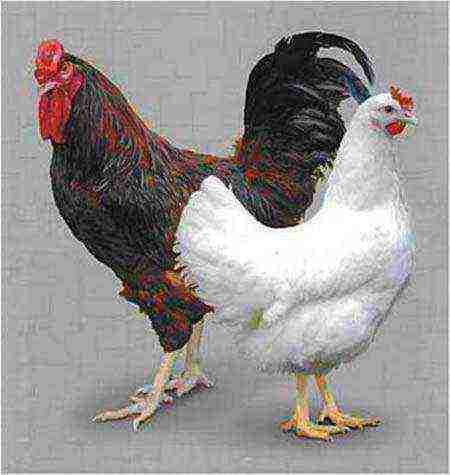 Hisex breed
Hisex breed
The advantages of chickens of the egg direction are often also their disadvantages.
- If the breeder wants to get meat in addition to eggs, you should pay attention to meat-and-meat chickens. They rush not much less, but they weigh an order of magnitude more. The meat-and-meat direction includes the following breeds of chickens: Foxy Chik, Dominant.
- All egg breeds are highly active. They run a lot, move, and can even fly over low fences. This quality can be troublesome. Breeders have to cost entire arenas so that birds do not run off the site, do not get on the road, do not hurt their paws, and do not attract the attention of predators.
- The best breeds of hens do not eat many layers, but the feed should be nutritious and should be given often. After the next oviposition, the chicken needs replenishment, so it is important to make sure that there is at least some food in the feeder at all times.
- Egg breeds bring the greatest benefit only in 1-2 years of life. Then their maintenance becomes unprofitable and therefore they are slaughtered. However, not all such breeds have tasty meat, so when choosing, you should also pay attention to this criterion.
When planning to have chickens and receive fresh eggs from them every day, a person naturally asks the question - which laying hens are the best? There are a great many breeds related to the egg direction on the market, they differ in appearance, size and cost. How not to miscalculate and become the owner of the best laying hen in all respects? Which chickens lay the largest eggs, which are unpretentious in care, and which are quite capricious? You will learn all this from our rating.
First place of the leader
If we proceed from which chickens fly the most, then in the first place will be the German breed of Loman Brown laying hens, which in recent years has been the undisputed leader in popularity. The main reason for this popularity is the high egg production of birds - 300-320 eggs per year. There is a good adaptation to the conditions of keeping - their productivity in large poultry farms and in small private farms is almost the same. It is also important that Loman Brown laying hens, in comparison with other popular breeds of chickens, are relatively inexpensive.
Small chickens of this breed have one important feature that contributes to the high popularity of the breed: in cockerels, the color of down is white, and in chickens, it is fawn. This allows for early gender segregation of the livestock. It is not difficult to breed acquired young animals, the indicator of viability in hatched chicks is 94-98%.
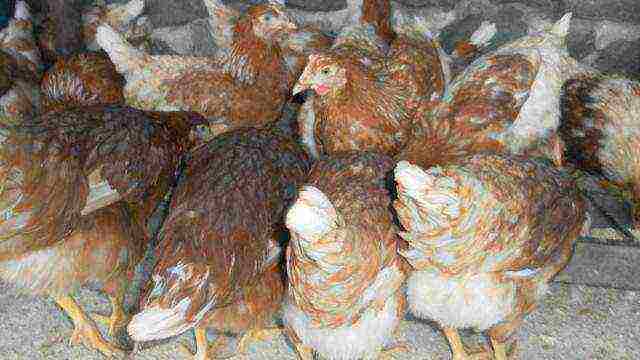
The weight of an adult chicken is 1.8-2 kg, of a rooster - up to 3 kg, which is more typical for the egg-meat direction than for layers. The eggs are large enough, the shell has a beautiful brown hue, the average egg weight is 63-64 g. Laying hens of the Loman Brown breed are friendly, obedient, not subject to excessive shyness. They feel good indoors, but even better outdoors. Early enough - at 5.5 months - they enter the productive age, after which they intensively lay eggs for 80 weeks.
Until now, Loman Brown chickens have had the optimal performance-to-effort / feed ratio among all laying hen breeds. But at the end of the 80-week period, the productivity of birds decreases rapidly, and their further maintenance becomes unprofitable, therefore, during this period it is more expedient to send them to slaughter.
Second place - Hisex Brown
Cross Hisex Brown, bred by domestic breeders, is a hybrid of white Leghorn. The average weight of adult chickens is up to 2.0 kg, males - up to 2.5 kg. Egg production is 280-315 eggs per year, only slightly inferior to Loman Brown. The eggs are very large, in a white or light brown shell, the average weight of eggs is up to 70 g (this is one of the best indicators). The safety of hatched chickens in this breed is close to 97%.
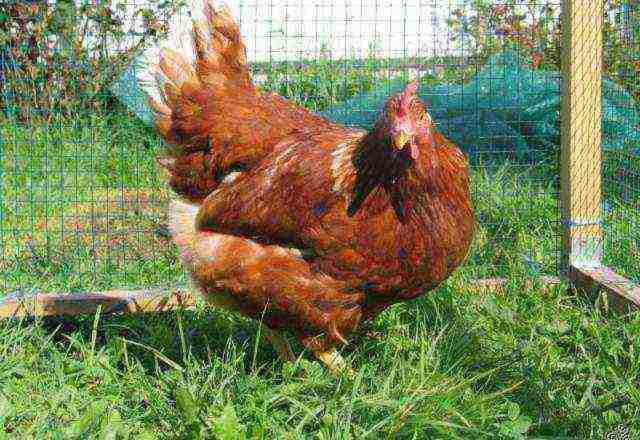
The main advantage of the eggs of this cross, in addition to their size, is their low cholesterol content. In other words, they are the most dietary of all dietary chicken eggs. Like Lohman, Hisex Brown's intensive egg-laying period lasts about 80 weeks, after which it drops sharply. The pleasant features for the owners include the fact that when the temperature rises in the habitat, the birds need less feed, but at the same time they rush just as productively.
Third place - Tetra chickens
Tetra chickens are in third place in our impromptu rating. If the task is to choose working hens that lay eggs all year round, then there is no competition for laying hens of the Tetra SL cross. True, in private farms, these birds are rare, since their productivity largely depends on the regime and a balanced diet.
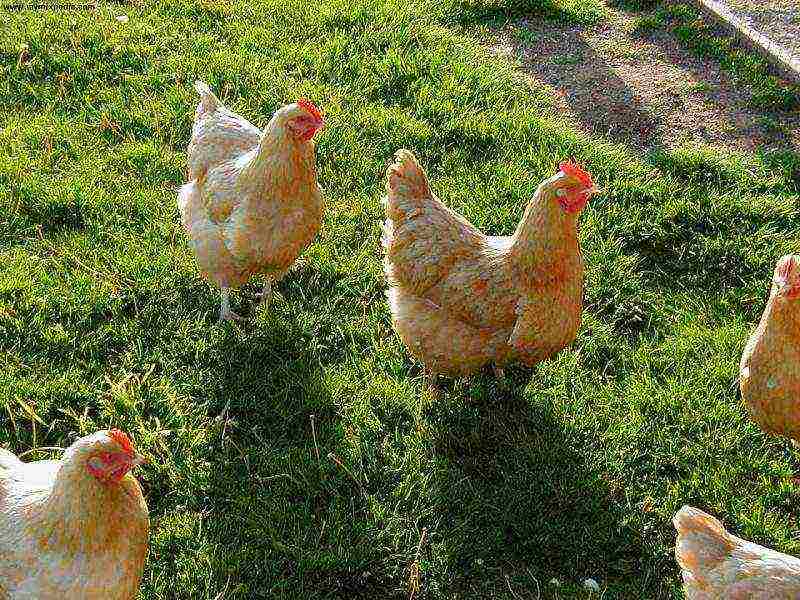
Under optimal conditions, birds are capable of laying an average of 310 eggs per year. The shell is brown, the average weight of the eggs is 64 g. To maintain such productivity, in addition to the main feed, 120 g of compound feed must be added every day per hen. With an increase in this rate to 150 g, birds will be carried almost daily.
Fourth place - Leghorn
The Leghorn chickens were slightly behind the leaders. What are the easiest poultry house dwellers to maintain and care for? It's them! More recently, Leghorn laying hens were considered the best among all breeds of chickens in terms of egg production. Today, breeds have been bred that are somewhat ahead of Leghorn in this indicator, but in terms of unpretentiousness, acclimatization to conditions and ease of keeping, these chickens are still the best.
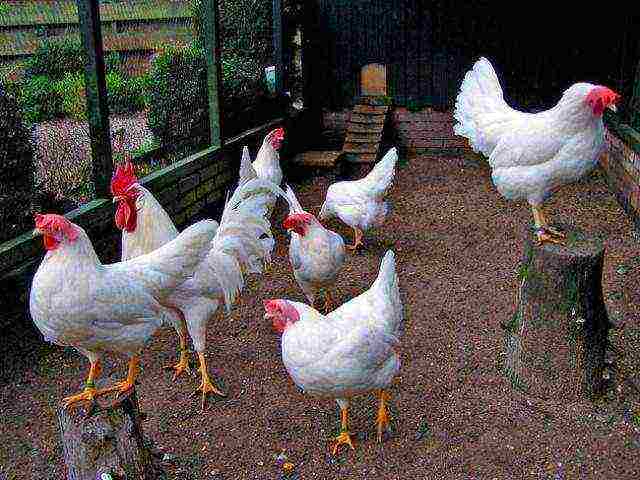
Adult Leghorn chickens weigh 1.5-2 kg, roosters up to 2.5 kg. Birds enter the productive age early - at 4.5-5 months and lay intensively during the entire first season, laying from 220 to 300 eggs weighing 55-58 g. The eggshell of the eggs is predominantly white. Chickens of this breed hold an absolute record - 365 laid eggs per year!
For all their advantages, these birds have one, but a very significant drawback - they have a poorly developed instinct for incubating chickens. When the first two or three chicks are born, the Leghorn mother often throws the rest of the eggs in the clutch, so it is better to breed chickens in an incubator. After the first season, the Leghorns' egg production decreases markedly, although not as catastrophically as that of the Browns. But still, after the birds reach this age, it is better to rotate the flock, replacing the old layers with young ones.
Video "Features of keeping thoroughbred layers"
In this video, you will see how to properly care for thoroughbred layers.
Loading …
